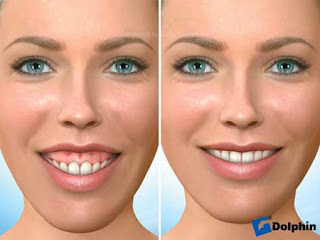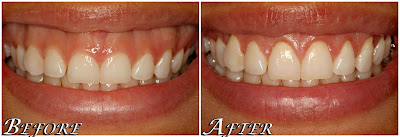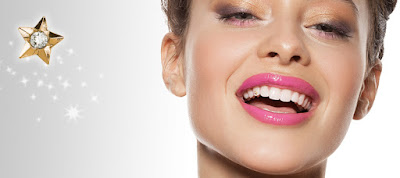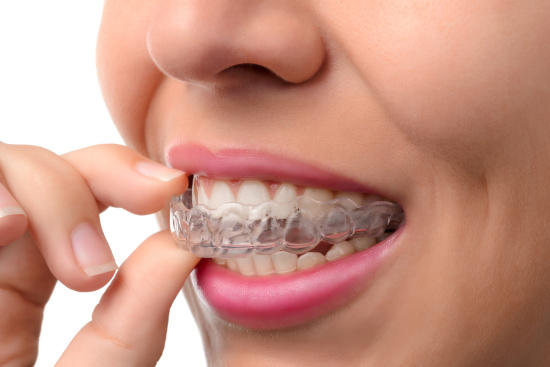What is cosmetic dentistry?
Dentistry is no longer just a case of
filling and taking out teeth. Nowadays many people turn to cosmetic dentistry,
or ‘aesthetic dentistry', as a way of improving their appearance. They do this
in the same way they might use cosmetic surgery or even a new hairstyle. The
treatments can be used to straighten, lighten, reshape and repair teeth.
Cosmetic treatments include veneers, crowns, bridges, tooth-coloured fillings,
implants and tooth whitening.
What is a veneer?
Veneers
are thin slices of porcelain. These are precisely made to fit over the visible
surface of your front teeth, like a false fingernail fits over a nail.
Why might I have a veneer?
Veneers
are an ideal way of treating discoloured or unsightly teeth, closing gaps
between front teeth, or repairing chips and cracks.
How are veneers fitted?
A
small amount of enamel is removed from the tooth, usually the same thickness as
the veneer will be. The dental team take an impression and send it to a dental
technician, who makes the veneer in a laboratory. The veneer is then bonded to
the tooth to form a strong and natural-looking repair.
Can I have white fillings?
For
over 150 years standard fillings have been made out of a silvery-grey material
called ‘amalgam'. This is considered one of the strongest and longest-lasting
materials for fillings. However, many people find it unattractive and some are
concerned about possible health risks.
White
fillings are now a popular alternative to amalgam fillings. The new dental
materials mean it is much easier to find a perfect match for the shade of a
particular tooth. In most cases, it is quite impossible to see that the tooth
even has a filling. Sometimes white filling material can be used to cover
unsightly marks on teeth, in a similar way to veneers.
My tooth is badly broken - what can I do?
When
a tooth is badly broken or heavily filled, the dentist may
need to crown or ‘cap' it to restore its appearance and strength.
How does the dentist make a crown?
The
usual method for fitting a crown involves shaping the tooth under local
anaesthetic and then taking an impression using a rubber-like material. The
impression is then sent to the laboratory along with the details of the shade
to be used, and the technician makes the crown.
What happens to my teeth while the crown is
being made?
While
your crown is being made, the prepared tooth can be protected with a temporary
crown. This is easily removed just before fitting the permanent one. In most
cases, the temporary crown is in place for about two weeks.
What is a crown made of?
Crowns can be made of a variety of different
materials, such as porcelain or porcelain bonded to metal. New materials are
continually being introduced. It is a good idea to talk to your dental team
about which crown would be best for you.
How can my dentist fill a gap in my mouth?
If a
tooth is missing, or needs taking out, there are several ways to fill the gap
that is left. In some cases it is important to try to replace any missing teeth
to balance the way your jaw bites. If you have several missing teeth, the
remaining teeth are under more pressure. This can lead to broken fillings or
even jaw problems.
A
partial denture is the simplest way to replace missing teeth. However, some
people find dentures uncomfortable and eventually decide to look at
alternatives, such as bridges or implants.
What is a
bridge?
Bridges
are ideal for people who don't like dentures and only have a few teeth missing.
Bridges are usually made by putting a crown on the teeth on either side of the
gap and attaching a false tooth in the middle. The bridge can't be removed.
These bridges are usually made of precious metal bonded to porcelain. Sometimes
other non-precious metals are used in the base to give it extra strength.
What if I don't want my remaining teeth
drilled?
Adhesive
bridges are another way of bridging a gap, and less of the tooth needs
removing. These bridges are made up of a false tooth with metal ‘wings' on
either side. These wings are made to bond to the teeth on either side, with
very little drilling needed. Instead, the teeth are roughened and the bridge is
fitted using a very strong composite resin.
Can implants be used to replace missing
teeth?
Implants
are an alternative to dentures and bridges, but they are more expensive.
Implants are titanium rods which are surgically placed into the jawbone and act
as anchors for fastening dentures or crowns onto.
Can I lighten the colour of my teeth?
Yes.
Tooth whitening can be a highly effective way of lightening the natural colour
of your teeth without removing any of the tooth surfaces. It cannot make a
complete colour change, but it should lighten the existing shade.
What does tooth whitening involve?
Professional
bleaching is the most common form of tooth whitening.
Your
dental team will apply the whitening product to your teeth, using a specially
made tray which fits into your mouth like a mouthguard.
The
‘active ingredient' in the product is usually hydrogen peroxide or carbamide
peroxide. As the active ingredient is broken down, oxygen gets into the enamel
on the teeth and the tooth colour is made lighter.
Once
your dental team has started this treatment you may be given the trays to take
home and continue the treatment, or you may need more appointments with the
team. This treatment can take around 3 to 4 weeks, depending on how long you
keep the trays in your mouth each time, and how much whiter you want your teeth
to be.
It is
important to remember that only natural teeth will be whitened, and that any
crowns, bridges or dentures you have will stay the same shade.
What other
tooth-whitening methods are there?
There
is now laser whitening or ‘power whitening'. During this treatment a light or
laser is shone on the teeth to activate the chemical. The light speeds up the
chemical reaction of the whitening product and the shade change can be achieved
more quickly. Laser whitening can make teeth up to five or six shades lighter.
This treatment usually takes about one hour and you must be seen by a qualified
dentist before starting treatment.
What is an 'incorrect bite'?
This
is when the teeth do not meet together properly or are not in balance with the
rest of the face, or if teeth are lost and not replaced.
What can happen if it is not treated?
If an
incorrect bite is not treated the face can ‘collapse'. This can cause the face
to sag, the chin to stick out or the smile to droop. It can even cause
headaches, neck pain and pain in other parts of the body.
How can it be treated?
There
are a number of treatments, including crowns, veneers and orthodontics (braces). Ask your
dental team which treatment is most suitable for you. Ask for an estimate of
the cost and a written treatment plan before you start.
Can my crooked or twisted teeth be
straightened?
Teeth
can be straightened with orthodontics (braces). This is usually done during the
teenage years, when the jaws are going through a period of growth. However,
many adults also have treatment to straighten their crooked teeth or to improve
their appearance. The treatment can take much longer in adults and is therefore
more expensive.
Some
people have clear or plastic braces, which are hardly noticeable. If you are
considering orthodontic treatment, first see your dental team and get their
advice. Your dental team can talk to you about your treatment options and if
necessary refer you to an orthodontist, a dentist who specialises in
straightening teeth.
There
are also now ‘invisible' braces. Your dentist will make you a series of clear
plastic shields (like a mouthguard) which need to be worn all day and gradually
move your teeth into a new position.
Are there any alternatives to orthodontics?
Cosmetic
contouring can be used to improve the appearance of teeth. It is ideal if you
have irregular-shaped or slightly crowded teeth.
However,
in contouring the teeth a small amount of enamel would be lost. Contouring can
also be used to improve the shape and appearance of your gums. These treatments
are not recommended for young children.
What is tooth jewellery?
Tooth
jewellery involves sticking small jewels onto the teeth using dental cement.
They should be fitted by a dentist, who can easily remove them if necessary. It
is important to keep the area around the jewel clean, as plaque can easily
build up around it and you will be more likely to get tooth decay.












